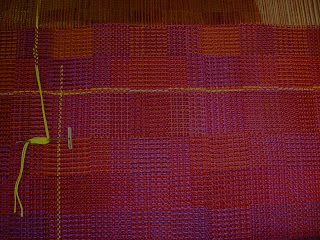
Sitting at the loom, I looked at the heddles that held those warp ends. I discovered that I had threaded 1,4,1,4,1,4. This is definitely not a crackle threading! Clearly I had inadvertantly omitted some heddles.
So I decided to go back to the post where I had given the original threading. In that process I discovered the post titled, "Who Spotted the Threading Error?" At first glance, the error there looks quite different from the current error. In the earlier post what is visible is the extra-long weft shots. But what called my attention to the error here was the repetition of those 3 red warp ends, each alternating with a beige weft. Those red warp ends were coming up too often. I did not notice the long overshots until I looked at the photographic blowup.
So the error was not caused by incorrectly threading a block, specifically by leaving out some heddles in that bit. That is what I thought while sitting at the loom. Rather, the error occurred, as I explained earlier, because I had failed to do a good job in writing out the transition from the last threading in the draft back to the first threading. The result was the appearance of an incorrectly threaded separate block.
It was a good thing I noticed those overshots and finally discovered the real problem. Just sitting at the loom, not aware of the overshot, I thought this threading might become an interesting design feature by using a different colored warp and repeating the threading a few times. Of course that would be possible anyway. But I would have to be willing to have some wefts shooting over more than three warp ends. But there are problems with longish wefts in fabrics meant to be used. They can easily catch on things, especially when the yarn is slippery like mercerized cotton or silk.
















